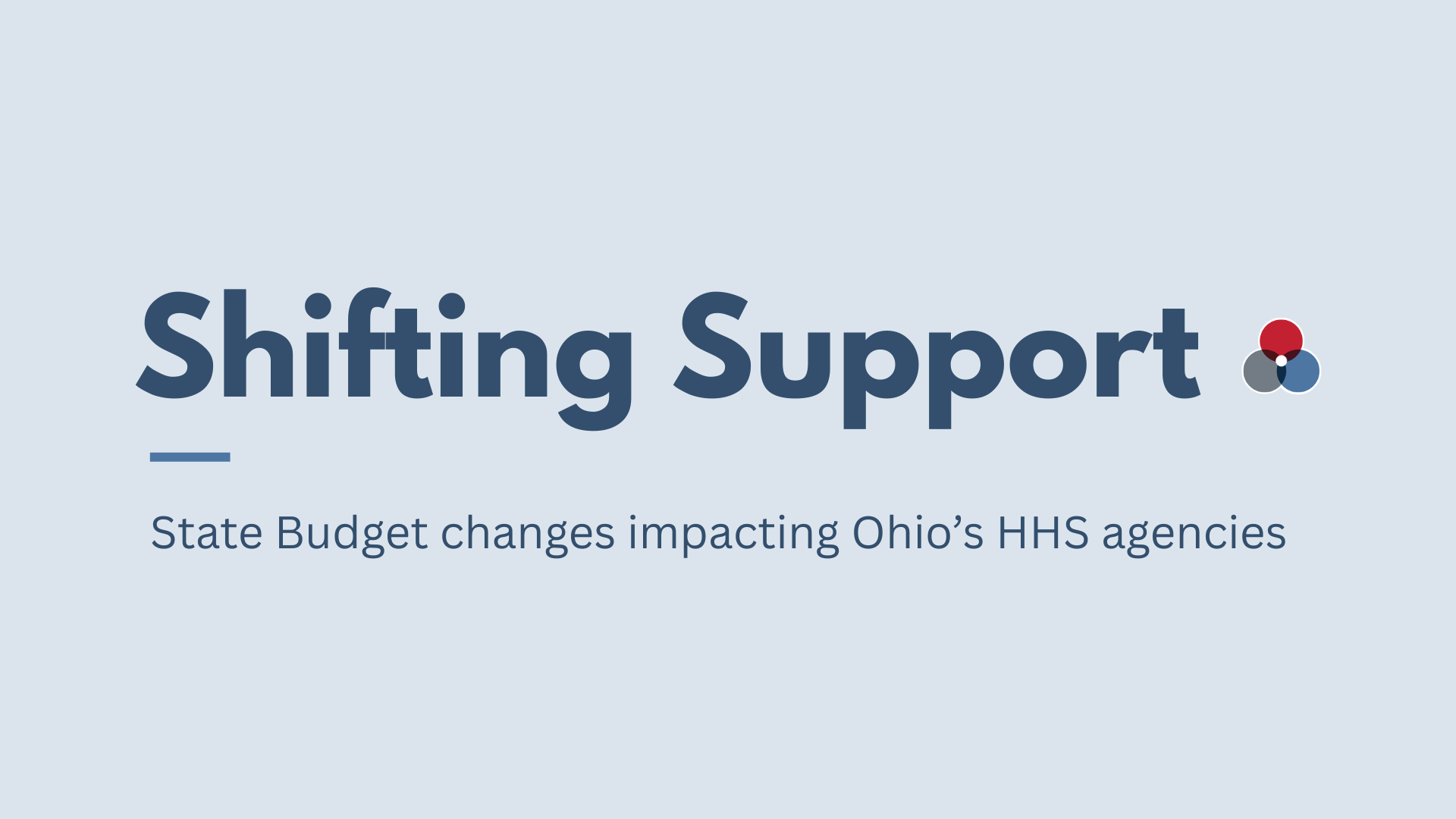INTRODUCTION
During the Great Recession, Ohio’s general revenue decreased by nearly $3.1 billion between state fiscal years 2008 and 2010, representing a downward shift of 16.4 percent.[1] This experience was not isolated to Ohio, however, as the average revenue decrease across states was 12.5 percent over that period.[2] At the time, Congress acted to provide additional resources to states to address their dire economic circumstances. Notably, this included increasing the federal share of payments that go to state governments through the Medicaid program via the Federal Medical Assistance Percentage (FMAP). As a policy strategy, this tool was incredibly effective in addressing states’ fiscal challenges, helping support budgets, provide health coverage to the newly unemployed and creating a critical stimulus that accelerated economic recovery. With similar economic challenges arising as a result of COVID-19, Congress, again, has an opportunity to facilitate the economic recovery of states through FMAP. If they do not act, and if policymakers in Ohio do not support this action, there will be dire consequences. Economically, the state budget will suffer, greatly, and Ohio’s most vulnerable communities and populations will be at risk.
KEY TAKEAWAYS
- Increasing FMAP is one of the most effective tools to provide resources to states and has been proven to mute recessions and enable job creation.
- Additional federal resources help states handle increases in caseloads without needing to cut services, eligibility or other priorities like education.
- Unlike the Great Recession, providers are also struggling as patients delay, postpone or forego care and Medicaid can be a critical backstop to ensure capacity is sufficient during the crisis.
- The elderly and disabled are not only more susceptible to harm from the virus, but are also the most likely to be impacted by cuts to Medicaid.
FMAP MECHANICS
The Federal Medical Assistance Percentage (FMAP) is the calculation that represents how much money is split between the state and federal governments. States must spend their own dollars for programs and then that amount is “matched” by the federal government in a process typically referred to as “draw down.” This number is usually represented as a percentage and is driven by a formula that considers the average per capita income for each state relative to the national average. Currently, Ohio ranks 34th in per capita income and is 38th in average growth since the recession.[3]
Currently, Ohio ranks 34th in per capita income and is 38th in average growth since the recession.
The Social Security Administration requires this “regular FMAP” match to be between 50 percent and 83 percent. FMAP rates also tend to lag behind the economy, meaning the adjustment of these rates often does not keep pace with major economic events, which can make the fiscal administration of the program more difficult. Currently, Ohio’s FMAP is at 63.02 percent, meaning money for Ohio’s regular Medicaid benefits are funded 63.02 percent by the federal government, and 36.98 percent by the state.It should also be noted, however, that many of the state’s resources in facilitating draw down come from fees assessed to providers like hospitals and nursing facilities. These are expressed as non-general revenue funds(Non-GRF). In state fiscal year (SFY) 2019, Non-GRF sources of Medicaid represented 38.7 percent of the state’s obligation for the program ($3.28 billion of $8.49 billion), meaning Ohio’s direct financing of the program is 19.3 percent, or $5.2 billion of the $25.9 billion allocated to finance the program.
Many of the state’s resources in facilitating draw down come from fees assessed to providers like hospitals and nursing facilities.
MEDICAID AND OHIO’S BUDGET
Medicaid has an anecdotal reputation as the predominant funding obligation of state resources, but the data suggests otherwise. Since SFY 1995 to SFY 2021, the state’s direct obligation to finance Medicaid has ranged between 10.8 and 16.8 percent with an average of 13.9 percent. Figure 1 demonstrates how these resources have been allocated over that timeframe:
FIGURE 1: OHIO MEDICAID AND THE STATE BUDGET


Upon closer inspection, as represented by Figure 2, growth in the Medicaid program, overall, has largely been tied to shifting health and human services funding from a state activity to something funded with federal dollars by the Medicaid program. This also is in the context of the Health Information Technology for Economic and Clinical Health (HITECH) Act’s provisions that provided funds to significantly expand the use of electronic medical records and the Patient Protection and Affordable Care Act’s (PPACA) funding associated with expanding Medicaid to able-bodied, childless adults.FIGURE 2: FMAP FINANCES STATE FLEXIBILITY

Functionally, Medicaid provides Ohio’s General Assembly with the flexibility to obligate its general revenue funds (GRF) to other activities such as education, corrections and to finance tax breaks that lower state revenue.When put into its context, Medicaid does not obligate state resources in a way that creates pressure in other areas of state budget policy. In fact, what is evident is the ways in which FMAP has enabled the state to maintain its commitments for other policy initiatives while providing critical stimulus and support for Ohioans.
LESSONS FROM THE GREAT RECESSION
Historically, Medicaid has muted economic downturns, lessening the loss in real gross domestic product (GDP) by 15 to 17 percent during the five recessions between 1969 and 1999.[4] During the Great Recession of 2008, the American Recovery and Reinvestment Act of 2009 (ARRA) included a provision to temporarily increase Medicaid FMAP (enhanced FMAP or “eFMAP”). The provisions related to this increase required states to ensure that services and coverage standards remained the same during the period of the increase, and that the FMAP number could change if a particular state had higher than average unemployment.[5]Figure 3 below shows what happened in Ohio during the Great Recession and how eFMAP played a role:FIGURE 3: eFMAP’S ROLE IN OHIO

Overall, Ohio accepted $3.46B in eFMAP which included increased federal funding of more than $3.1 billion in SFY09 and SFY10. At the same time, the state’s obligation, including GRF and Non-GRF went down by $886.3 billion. Enrollment in Ohio’s program increased by 255,962 individuals. Given Ohio’s worse than average unemployment rate, Ohio’s FMAP was closer to 72.34 percent in SFY09 and 73.47 percent in SFY10, which was an increase of more than 13 percent during that timeframe.
These resources not only provided a source of relief for Ohio’s budget through that enhanced return, but eFMAP, specifically, was shown to help accelerate economic recovery in states.
Outside of the mechanical impact of eFMAP, these resources enabled the state to increase its return on state match. This return is often described though a metric called a “multiplier.” Prior to the Great Recession, Ohio’s multiplier was 1.55, meaning every $1 the state used to finance Medicaid returned $1.55 to the state. After eFMAP, that number grew to 2.62 in SFY09 and 2.77 in SFY10. Once the eFMAP ended in SFY11, the multiplier decreased to 1.75. While eFMAP terminated, Ohio’s economic conditions were still more depressed when compared to other states, which is why the multiplier was higher in SFY11 (1.75) than it was in SFY08 (1.55). That said, these resources not only provided a source of relief for Ohio’s budget through that enhanced return, but eFMAP, specifically, was shown to help accelerate economic recovery in states, which directly led to job creation both inside and outside of health care.[6]
COVID-19
The Families First Coronavirus Response Act (FFCRA) also provided eFMAP to states in an amount mirroring the 6.2 percent that was provided in ARRA. The policy contains similar maintenance of effort (MOE) provisions for states in order to access these increased resources, and it is only available during the national emergency, with an expiration date set for the last day of the quarter in which the emergency is terminated.[7] Estimates have shown that Ohio could receive as much as $1.2 billion.[8]
Long term, 1.7 million Ohioans may lose their health insurance coverage through their employers as a result of the pandemic.
Long term, 1.7 million Ohioans may lose their health insurance coverage through their employers as a result of the pandemic, with upwards of 953,000 Ohioans gaining coverage through the state’s Medicaid program.[9] Reports from the Ohio Department of Medicaid have already shown that nearly 350,000 more individuals have signed up for coverage so far and many more are expected. While the FFCRA provision will help Ohio manage its finances in the short term, there are longer-term impacts that will be felt by providers and insurers.The Coronavirus Aid, Relief, and Economic Security (CARES) Act, Paycheck Protection Program and Health Care Enhancement Act have provided $175 billion in relief to hospitals and other health care providers. As of May 13, Ohio providers have received $1.15 billion.[10] For Ohio’s hospitals, the Cleveland Clinic received $103.3 million (second most nationally) and the state’s rural hospitals received a total of $370 million. While these resources will help the delivery system respond to the emergent need, hospitals are significantly financially challenged by the interruption in business the pandemic represents.
The health care industry has seen the single largest decline in jobs in three decades with nearly 1.4 million jobs lost since March.
Due to hospitals postponing many of the elective and non-essential services they typically provide, the health care industry has seen the single largest decline in jobs in three decades with nearly 1.4 million jobs lost since March.[11] Reports from Ohio have indicated that hospitals could lose up to $1.2 billion in revenue every month.[12] For insurers, there is an inverse situation, but the impact may only be delayed. According to the actuarial firm Milliman, insurers may see a net reduction in expenses of up to $575 billion during the 2020 calendar year.[13] However, it still remains to be seen what impact COVID-19 will have on insurance costs in terms of treatment and testing, which may total as high as $251 billion.[14] Furthermore, with pent up demand for non-essential services, premiums may spike next year as hospitals seek to shore up their finances, provide these services, and negotiate higher rates where there is a shortfall, especially as Medicaid covers more people.
WHAT CAN BE DONE TO PROTECT OHIO’S BUDGET
Moody’s Analytics performed a stress-test on state budgets as they respond to COVID-19 and predicted that Ohio’s budget shortfall could be anywhere from $2.9 billion to $4.3 billion through September 2021. Additionally, with Medicaid absorbing 24 percent of the privately-insured market, Ohio may need to increase spending between $2.2 billion and $2.5 billion just to keep the program where it is today. All told, this could mean a financial shock on the order of $5.1 billion to $6.8 billion.
Ohio’s budget shortfall could be anywhere from $2.9 billion to $4.3 billion through September 2021.
Medicaid financing is a blunt instrument. As costs increase, the options to contain costs either revolve around cutting rates, limiting eligibility or reducing services. Since health care is Ohio’s second largest industry, cutting provider rates may accelerate job loss and further challenge the delivery system that is primarily responsible for responding to the pandemic. In regards to limiting eligibility, the populations that would most likely garner the most financial benefit are populations that would be incredibly difficult to cut, legally and politically.While the Medicaid expansion population represents 23.8 percent of Ohio Medicaid enrollees, that population only represents 21.8 percent of Medicaid expenditures and, of those expenditures, 90 percent of those costs come from the federal government through a separately established and permanent FMAP. What’s more, expansion has been proven to keep private insurance premiums lower, so eliminating the coverage for this population would artificially inflate private insurance costs.[15] For those populations that are financed at the “regular FMAP,” nearly 60 percent are children and parents, representing 28 percent of the expenditures, and 14 percent are the disabled and elderly, representing 49.2 percent of the expenditures. As the evidence suggests, these populations are the most at risk in regards to COVID-19 mortality and, as such, limiting enrollment or cutting benefits may not be a sound strategy to prevent mortality. Of course, the state could obligate more GRF from other parts of the budget, but this could then mean significant cuts to the other predominant areas of funding in Ohio’s budget: education, corrections or both. The state could also use its rainy-day funds, but there would still be a significant shortfall. It is also unlikely Ohio would seek additional revenue through taxes at a time when businesses are struggling to stay open. As such, supporting a temporary increase to the eFMAP may be the best option for states moving forward.Moody’s Analytics looked at the FFCRA and found the current FMAP increases were ”relatively small,” and that enhanced FMAP would be an ”extremely efficient and timely way to get additional funds to state governments quickly, as state policymakers begin to grapple with the budget impacts of COVID-19.” The National Governor’s Association has recently advocated for such a policy, requesting eFMAP to be increased to 12 percent with an MOE provision tied to a state’s unemployment rate, a policy which was built upon in the recently introduced Health and Economic Recovery Omnibus Emergency Solutions (HEROES) Act.[16]Given the direct relationship between eFMAP and vulnerable populations, the MOE is a necessary protective factor for the elderly, people with disabilities and children.
Ohio policymakers on the local, state and federal levels should support a temporary eFMAP with an MOE provision tied to Ohio’s unemployment rate.
CONCLUSION
Ohio policymakers on the local, state and federal levels should support a temporary eFMAP with an MOE provision tied to Ohio’s unemployment rate. More Ohioans are signing up for Medicaid, and resources are needed. During the Great Recession, eFMAP supported Ohio’s budget, accelerated recovery and created jobs. As opposed to the Great Recession, however, COVID-19 acutely affects the economic well-being of the health care industry and eFMAP can compensate for those challenges. If Ohio does not support this policy, lawmakers will be sacrificing the economic well-being of Ohio businesses, artificially create an avoidable budget crisis and put some of its most vulnerable citizens at risk.[1] “Legislative Service Commission – GRF Revenue History.” Legislative Service Commission. Accessed May 13, 2020. https://www.lsc.ohio.gov/pages/reference/current/historicalrevandexpenditure.aspx.[2] “Fiscal 50: State Trends and Analysis.” The Pew Charitable Trusts. Accessed April 17, 2020. https://www.pewtrusts.org/en/research-and-analysis/data-visualizations/2014/fiscal-50#ind7.[3] Ibid.[4] “Medicaid Could Help Economy Recover During Recession, Joint Center for Political and Economic Studies, Report Says.” Commonwealth Fund. Accessed April 17, 2020. https://www.commonwealthfund.org/publications/newsletter-article/medicaid-could-help-economy-recover-during-recession-joint-center.’[5] “ARRA - Medicaid FMAP Increase Provisions.” Search Results Web Result with Site Links National Conference of State Legislatures. Accessed May 10, 2n.d. https://www.ncsl.org/print/statefed/ARRA-MedicaidFMAPIncreaseProvisions.pdf.[6] Wilson, Daniel J. American Economic Journal: Economic Policy 2012, 4(3): 251–282. April, 2020. https://www.frbsf.org/economic-research/files/wp10-17bk.pdf.[7] “Families First Coronavirus Response Act – Increased FMAP FAQs.” The Center for Medicare and Medicaid Services. Accessed May 7, 2020. https://www.medicaid.gov/state-resource-center/downloads/covid-19-section-6008-faqs.pdf.[8] Sullivan, Jennifer. “Medicaid Funding Boost for States Can't Wait.” Center on Budget and Policy Priorities, April 21, 2020. https://www.cbpp.org/blog/medicaid-funding-boost-for-states-cant-wait.[9] “COVID-19 Impact on Medicaid, Marketplace, and the Uninsured, by State.” Health Management Associates, April 3, 2020. https://www.healthmanagement.com/wp-content/uploads/HMA-Estimates-of-COVID-Impact-on-Coverage-public-version-for-April-3-830-CT.pdf.[10] “HHS Provider Relief Fund.” Centers for Disease Control and Prevention. Accessed May 14, 2020. https://data.cdc.gov/Administrative/HHS-Provider-Relief-Fund/kh8y-3es6.[11] Sanger-katz, Margot. “Why 1.4 Million Health Jobs Have Been Lost During a Huge Health Crisis.” The New York Times. The New York Times, May 8, 2020. https://www.nytimes.com/2020/05/08/upshot/health-jobs-plummeting-virus.html.[12] Haefner, Morgan. “Ohio Hospitals Could Lose $1.2B a Month from Suspended Elective Surgeries: Hospitals in Ohio Could Face $1.2 Billion in Lost Revenue Due to Suspending Nonessential Procedures in Light of the COVID-19 Pandemic, According to Columbus Business First.” Becker's Hospital Review. Accessed May 14, 2020. https://www.beckershospitalreview.com/finance/ohio-hospitals-could-lose-1-2b-a-month-from-suspended-elective-surgeries.html.[13] Rogers, Hayley, Charlie Mills, and Matthew J. Kramer. “Estimating the Impact of COVID-19 on Healthcare Costs in 2020.” Milliman. Accessed May 9, 2020. https://milliman-cdn.azureedge.net/-/media/milliman/pdfs/articles/estimating-the-financial-impact-covid19.ashx.[14] King, Robert. “COVID-19 Could Cause Insurance Premiums to Spike as Much as $251B next Year: Report.” FierceHealthcare, March 23, 2020. https://www.fiercehealthcare.com/payer/covered-california-covid-19-testing-treatment-costs-could-lead-to-higher-premiums-2021.[15] Semanskee, Ashley, Cynthia Cox and Larry Levitt. “Data Note: Effect of State Decisions on State Risk Scores.” The Henry J. Kaiser Family Foundation, October 7, 2016. https://www.kff.org/health-reform/issue-brief/data-note-effect-of-state-decisions-on-state-risk-scores/.[16] “Governors' Letter Regarding COVID-19 Aid Request.” National Governors Association, April 30, 2020. https://www.nga.org/policy-communications/letters-nga/governors-letter-regarding-covid-19-aid-request/.








